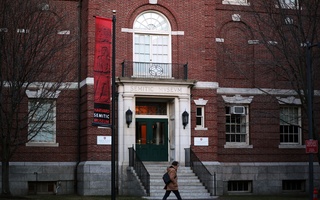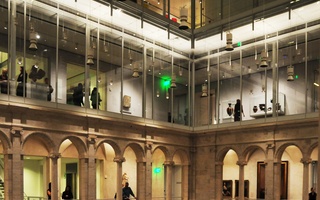{shortcode-38433293bdb9402492582fa29433c88d039ea84b}
Weaving through the various exhibitions at the Harvard Museum of Natural History, Jane Pickering makes a brief detour toward the newly installed hive frame—a temporary exhibit created in collaboration with the Harvard Undergraduate Beekeepers—to check on the bees. Apparently, the queen had not laid any eggs recently, scaring personnel in the museum. For Pickering, the bees’ well-being is one of many responsibilities that come with her job. The others extend farther, across a multitude of exhibits and past museum boundaries themselves.
Pickering is the first executive director of the Harvard Museums of Science and Culture. Established in 2012, the consortium acts as an umbrella organization for six Harvard museums operated under the Faculty of Arts and Sciences: the Harvard Museum of Natural History (which unifies the Museum of Comparative Zoology, the Harvard University Herbaria, and the Mineralogical and Geological Museum), the Peabody Museum of Archaeology and Ethnology, the Harvard Collection of Historical Scientific Instruments, and the Harvard Semitic Museum. Assisting the associated museums with programming and outreach, the Harvard Museums of Science and Culture seeks to streamline public relations. “[FAS] formed this alliance because there are certain things that we wanted to do together, but also to more efficiently coordinate the outward facing part—the parts involved with the communities—of the museums,” says Peter L. Galison, faculty director at the Collection for Historical Scientific Instruments.
At the same time that the Harvard Museums of Science and Culture clarifies the divide between public relations and private operations of the museums, it assists in blurring the lines between different disciplines at Harvard. The formation of the Harvard Museums of Science and Culture ushers in a new era for six museums that have existed for the most part independently for years. As the Harvard Museums of Science and Culture continues to launch its programs, it presents a case study of the unique and collaborative interdisciplinary culture at Harvard.
THE PUBLIC ARM
The museums included in the Harvard Museums of Science and Culture are diverse not only in discipline but also in scope. Each museum houses a considerably large collection in a different field, from Near Eastern archaeology, history, and culture in the Semitic Museum to minerals and zoological artifacts in the Harvard Museum of Natural History. Yet, while the museums are externally different, they all share a common goal: a commitment to educating Harvard affiliates.
“Today, we still see the [Semitic Museum] as a center to teach about culture and to house the teaching collection,” says Peter Der Manuelian, director of the Harvard Semitic Museum. As an organization under the FAS and led by faculty members within Harvard, the Harvard Museums of Science and Culture devotes considerable time to maintaining its collections for academic purposes.
“What we do with the collection is really [provide] a place for research and teaching,” says Jean-Francois Gauvin, director of administration for the Collection of Historical Scientific Instruments. “We’re open for the public, but we’re not meant to have 100,000 visitors a year. Our main audience is the Harvard community.”
Such sentiments present a dilemma for the museums, however. While the staffs of the individual museums care about academia, they also have public exhibitions to maintain. In this sense, the Harvard Museums of Science and Culture functions to allow the museums to balance their public and private faces. “HMSC has been working hard with us to help reach that [public] audience and make collections...better known to the Harvard community,” says Jeffrey Quilter, director of the Peabody Museum. “Now that we no longer have [to administer] the education program and public events...[we can focus on] taking good care of our collections and working to get those collections viewed by Harvard students and faculty.”
Sara Schechner, staff curator for the Collection of Historical Scientific Instruments, says that, for the collection, curatorial operations have not changed; what is different is its publicity and the new coordination among the members in the consortium concerning programs and event dates. In that way, within each museum’s inner framework, the Harvard Museums of Science and Culture does little except to streamline the marketing and outreach process. The effects of the Harvard Museums of Science and Culture, however, are far from limited.
BUILDING BRIDGES
Donald H. Pfister, curator of the Farlow Library and Herbarium of Cryptogamic Botany, sits in the Earth and Planetary Sciences gallery of the Harvard Museum of Natural History, a large space filled with a collection of rocks and minerals. Situated on the third floor of the building, the room, like all others on the floor, allows access to the Peabody. But as Pfister reflects on the relationship between the museums in the past, he notes the imperfections of the museums’ relationships before the Harvard Museums of Science and Culture. “There were never physical barriers. This floor pretty much had always been interconnected,” he says. “There was a sense of subtle intellectual barriers that are probably still there to some extent, but the idea is now we’re looking across the museums to make the experience and the possibilities greater.”
While collaboration is not a novel concept for museums—for instance, Schechner says that the Collection of Historical Scientific Instruments always borrows from other collections for their exhibitions—the Harvard Museums of Science and Culture allows for different forms of cooperation. The consortium specifically plans to curate some exhibitions within each museum and to pull from the expertise of other Harvard professors. This plan has already manifested in “Finding Our Way: An Exploration of Human Navigation” in the Collection of Historical Scientific Instruments. Curated by physics professor John Huth, the exhibit was planned by staff at the Harvard Museums of Science and Culture from beginning to end. “HMSC helps to operationalize things like exhibits and public programs, but what they like to call content knowledge has to come from us and from faculty,” Quilter says. “We help the HMSC identify what faculty members to contribute to the public programs in the exhibits and provide that kind of expertise ourselves.”
Pickering says that, practically, such collaboration is useful; for instance, publicity is easier if there are more partners involved working to get the word out. “More philosophically, the world is a complicated place and the challenges involve some interdisciplinary work,” she says, adding that measures like the Harvard Museums of Science and Culture allow for such integrative studies to occur.
Through such efforts, a thriving community flourishes among the museums. “[The collaboration] never was organic in the way that it is now,” Pfister says. “I think that everybody is thinking about the museum as a whole, less so...as units within FAS.”
Read more in Arts
Boston Calling September 2015: The Avett BrothersRecommended Articles
-
Plans Revealed for MuseumsIn a few years, Lamont won’t be the only place where students cram for finals. Last week, the Harvard Art
-
 Pomp Marks Student Opening of Renovated Harvard Art Museums
Pomp Marks Student Opening of Renovated Harvard Art Museums -
 Pictures at an Exhibition
Pictures at an Exhibition -
 Semitic Museum Fundraises to Increase Digitization
Semitic Museum Fundraises to Increase Digitization -
 Tedeschi Named Next Art Museums Director
Tedeschi Named Next Art Museums Director













